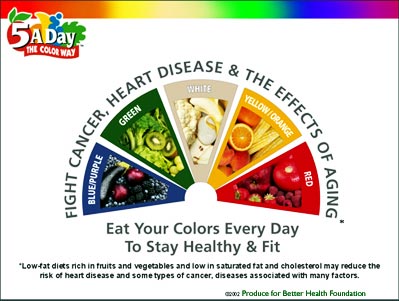
Return to the Monitor front Page
For more information on CECHE and its programs visit CECHE's Homepage

CECHE Chairman Sushma Palmer Comments on This Quarter's Topics

Action, not Reports, Needed to Reverse Diet, Nutrition Woes

 The
"5 A Day" Campaign: Are Americans Listening?
The
"5 A Day" Campaign: Are Americans Listening? Sedentarism
Runs Rampant Worldwide
Sedentarism
Runs Rampant Worldwide
 South
Indian Reproductive Health Tied to Cultural Roots
South
Indian Reproductive Health Tied to Cultural Roots Democracy
and Health Go Hand in Hand
Democracy
and Health Go Hand in Hand
 Guidelines
Dictate Lifestyle Changes for Americans
Guidelines
Dictate Lifestyle Changes for Americans WHO
Is Central to Fighting NCDs
WHO
Is Central to Fighting NCDsDownload a complete Monitor (PDF)
by Elizabeth Pivonka, Ph.D., President, and Frances Taccone, Ph.D., R.D., Development Director, Produce for Better Health Foundation, Wilmington, Delaware
 Meanwhile, the science behind the health benefits of eating vegetables and
fruit has grown stronger. A range of epidemiological studies over the last
several decades from around the world demonstrate that frequent consumption
of vegetables and fruit is associated not only with a reduction in cancer
risk, but also with a lower risk of developing hypertension, myocardial
infarction, coronary artery disease, cataracts, and asthma and other lung
diseases. In addition, regular intake of vegetables and fruit may help maintain
memory and promote healthy aging, urinary tract health, strong bones and
teeth, and healthy body weight and blood sugar levels. (Download
"The Health Benefits of Fruits & Vegetables" from www.5aday.com\.) While
the mechanisms by which vegetables and fruit might improve human health
are not fully known, there is ample scientific basis on which to recommend
eating five to10 servings of vegetables and fruit each day.
Meanwhile, the science behind the health benefits of eating vegetables and
fruit has grown stronger. A range of epidemiological studies over the last
several decades from around the world demonstrate that frequent consumption
of vegetables and fruit is associated not only with a reduction in cancer
risk, but also with a lower risk of developing hypertension, myocardial
infarction, coronary artery disease, cataracts, and asthma and other lung
diseases. In addition, regular intake of vegetables and fruit may help maintain
memory and promote healthy aging, urinary tract health, strong bones and
teeth, and healthy body weight and blood sugar levels. (Download
"The Health Benefits of Fruits & Vegetables" from www.5aday.com\.) While
the mechanisms by which vegetables and fruit might improve human health
are not fully known, there is ample scientific basis on which to recommend
eating five to10 servings of vegetables and fruit each day.The 5 A Day for Better Health program was specifically designed to do just that: recommend -- and increase -- vegetable and fruit consumption among Americans. Started as a pilot project in 1988 at the California Department of Health with a grant from the National Cancer Institute (NCI), the program rapidly gained support and went national in 1991. PBH was founded to work with NCI on this national program. Over the next decade, the foundation delivered the "5 A Day" message via hundreds of supermarket produce departments, the media, and vegetable and fruit growers licensed to use the "5 A Day" logo on certain produce.
In addition, NCI funded nine "5 A Day" research projects, conducted public relations outreach, and managed "5 A Day" coordinators in every U.S. state and the military. In 2001, NCI expanded the program to include the Centers for Disease Control and Prevention, and several parts of the U.S. Department of Agriculture. Together with the American Cancer Society and other industry and public health groups, the institute also formed a National 5 A Day Partnership, governed by a steering committee of 10 members and chaired by PBH.
PBH unveiled its "Color Way" campaign in October 2002, urging consumers to eat a colorful array of vegetables and fruit, including at least one daily serving from each of five color groups -- blue/purple, green, white, yellow/orange and red. The campaign features: consumer relations materials; a store retail program; a TV public service announcement; national public relations; a redesigned Web site (www.5aday.com); school cafeteria posters; and a nutrition education program reaching 1 million school children in partnership with the makers of Crayola crayons. The "Color Way" campaign and "5 A Day" intervention may have played a role in the slight increase in vegetable and fruit intake recorded between 1991-1997 by the USDA's "Continuing Survey of Food Intake By Individuals." And without this intervention, the decline in consumption witnessed in the last decade would have been much greater, PBH estimates.
More recently, PBH has been working with the World Health Organization (WHO) to bring together nations around the globe to share "5 A Day" implementation strategies. The 3rd International "5 A Day" Symposium, convened in Berlin in January 2003, was the culmination of this joint effort. Next steps -- in the works with WHO -- include a Global 5 A Day Partnership scheduled for Rio de Janeiro in November 2003.
[Next Features Article]
© 2003 CECHE